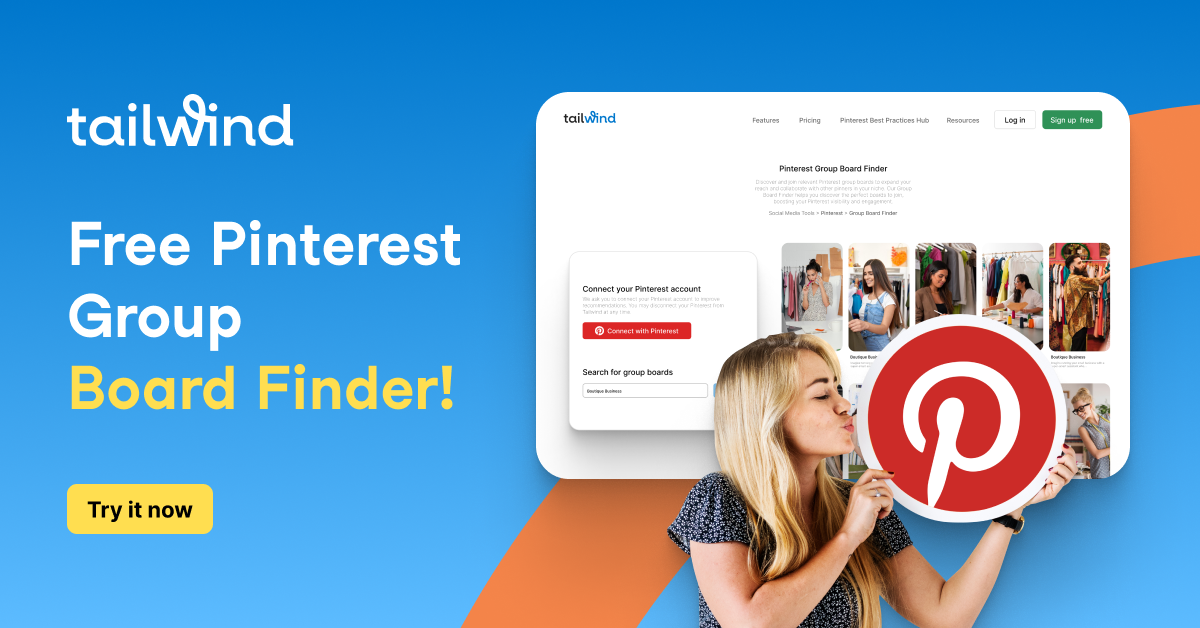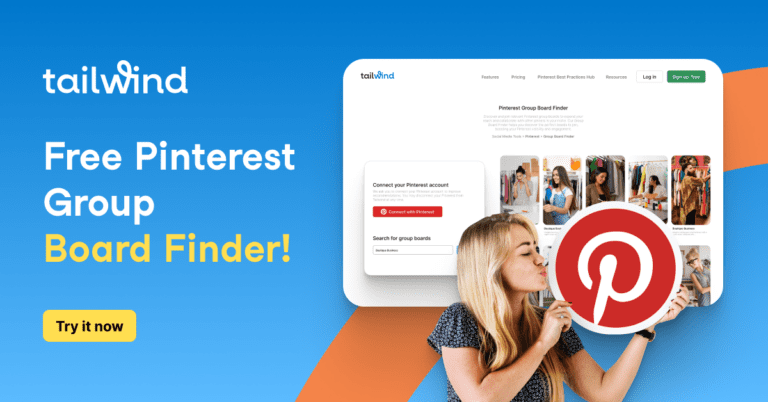When you are growing your business, you must make the most of all the tools and channels available to you.
Some take money to fully leverage, some take time. Pinterest is right there in the middle — one of those few channels that you can grow organically very quickly.
Not only that, but with Pinterest, you can also gain valuable insights into your audience and use it in your other marketing endeavors!
Creative Content Strategies
When leveraging Pinterest as part of your social media marketing, remember it’s a visual platform, so your content needs to pop.
Start by ensuring your profile is fully optimized with a clear description of your small business. Use relevant keywords to boost your visibility on this visual search engine.
Creating Boards:
Your Pinterest boards should reflect various aspects of your brand.
For instance, if you sell clothing, create boards for different styles or seasons. Home decor businesses can showcase different room inspirations.
Always pepper in holidays and events to capitalize on seasonal searches.
Perfecting Pins:
- Imagery: Use high-quality, visually-appealing images for your pins. The goal is to make someone stop scrolling.
- Pin Descriptions: A compelling, keyword-rich description can increase engagement.
- Rich Pins: These are ideal for sharing blog posts with automatic updates right from your website.
Utilizing Videos:
Don’t ignore the power of video pins for storytelling or demonstrating your products. Videos often have higher engagement rates, leading to more conversions.
Linking Strategy:
Ensure every pin links back to your website or blog. It not only helps with SEO but also directs traffic to your site for potential sign-ups or sales.
Engagement Techniques:
Regular pinning keeps your feed fresh and relevant. Use Tailwind for scheduling pins.
Engage with your community through comments and repins to build a loyal following.
Market Research:
Keep an eye on what’s working. Keep your content strategy flexible to adjust to what yields the best ROI.
See what active users are pinning from your niche and try to tap into those trends.
Employ Pinterest Lens for visual search and make sure your visuals are ready for this feature.
Lastly, you can consider Pinterest advertising for a paid boost to your most powerful pins.
Utilizing Pinterest for Market Research
When crafting your Pinterest marketing strategy, think of the platform as a goldmine for market research. As a small business, you can tap into a vibrant community to understand your target audience better.
Firstly, create your business profile. This profile is your front door on Pinterest and gives you access to invaluable analytics.
Through Pinterest’s analytics, monitor what your audience loves by looking at which of your pins generate the most engagement and traffic to your website.
- Know Your Audience: Use Pinterest to survey what’s trending among different demographics. Find out what your audience is pinning to understand their interests and preferences.
- Track Engagement: Keep an eye on which of your products or blog posts receive more saves and shares. High engagement can indicate a higher likelihood of purchase or conversion.
- Competitor Analysis: Peek at your competitors’ Pinterest pages. What are they pinning? What sort of engagement are their pins getting? This can reveal gaps in the market or opportunities for you to explore.
- Spot Trends: Pinterest users love to pin the latest and greatest. Monitor trends to stay ahead in product development or content creation.
Remember, your aim is to understand what drives Pinterest users to pin and, ultimately, what inspires them to make a purchase.
Leveraging Pinterest SEO
To boost your small business on Pinterest, start by considering SEO (Search Engine Optimization) habits that can drive more traffic to your pins. Pinterest operates similarly to a search engine, which means your content must be discoverable.
- Ensure your profile includes a clear description of your brand and relevant keywords that resonate with your business.
- Create boards that reflect your brand and what you offer. Each board should target a specific category or theme, making it easier for Pinterest’s search engine to categorize your content.
- Use descriptive titles and include keywords naturally within your board descriptions.
- When it comes to pins, their quality and how you describe them matter.
- High-resolution images with pin descriptions using relevant keywords can improve visibility.
- It’s much like how you’d optimize a webpage’s metadata for a search engine.
- Be sure to sprinkle relevant keywords in the description, but keep it readable and engaging.
The URL of each pin can contribute to better SEO, too. Tailor it to reflect the pin’s content and include keywords where applicable.
This tactic helps your pins become more discoverable — not just on Pinterest but also via other search engines.
Engagement is key on all social media platforms, and Pinterest is no exception. Pins that receive more engagement through saves and comments tend to rank higher.
Encourage users to interact with your pins: ask questions in your descriptions or create an incentive for users to comment.
Remember, your Pinterest marketing strategy should focus on connecting with your audience.
Track what competitors do but maintain your unique approach.
Aim for consistent branding across all pins to establish recognition and trust—all essential elements for boosting conversions and fostering a strong online presence.
Boosting Ecommerce Sales
Pinterest can act as a significant boost for your ecommerce sales.
With Pinterest for Business, you can tap into a community eager to discover and purchase products.
Creating eye-catching pins for your items — especially if you’re in the clothing, fashion, or home decor industries —can drive traffic and conversions to your online store.
Start by crafting high-quality visuals of your products. Ensuring your product pins are rich with information like price and availability will help potential customers make quick purchasing decisions.
Here’s a quick guide to using Pinterest to increase your online presence and sales:
- Pinterest Ads: Invest in promoted pins to target your ideal customer effectively, boosting both your visibility and potential sales.
- Optimized Pins: Include relevant keywords in your pin descriptions to improve discovery through Pinterest’s search function.
- Engage with Your Audience: Build relationships with followers by replying to comments and questions on your pins.
- Track Your ROI: Use Pinterest analytics to track your success and adjust your strategy to maximize your return on investment.
Make sure your pins link directly to the purchase page for a seamless shopping experience, clearing the path for those conversions.
Stay active and consistent with your pinning strategy, and watch as your sales begin to climb.
Exploring Pinterest Advertising
Just a quick repeat: when diving into Pinterest advertising, your first step is to create a Pinterest Business Account. This grants you access to advanced tools that track the performance of your pins and ads.
Here’s a quick rundown:
- Promoted Pins: These work like regular pins but with a boost—seen by more people. They blend seamlessly into the user’s feed, providing a non-disruptive experience.
- Pinterest Ads: These serve as the backbone of paying to display your content prominently. You can target your audience with precision based on interests, demographics, and more, driving meaningful traffic to your site.
- Since Pinterest is a visual search engine, ads that contain high-quality images or videos tend to perform better. Make your content stand out!
Analyzing Pinterest Metrics
When diving into Pinterest analytics, it’s like getting a backstage pass to what’s resonating with your audience.
You’ve got a whole dashboard at your fingertips to track how your content is performing and how users engage with your pins.
Start by checking out the overall engagement. Look for metrics like:
- Repins: Are people saving your pins to their boards?
- Clicks: Do your pins prompt users to hop onto your website?
These numbers are golden because they reflect initial interest and can direct your content strategy.
Next up, sift through the traffic details. You’re looking for trends that tell you which pins drive the most website traffic.
This is where your blog could shine. Pins with engaging descriptions, especially those leading to informative blog posts, often attract clicks.
Now, let’s talk video. If you’re using video pins, scrutinize those views! Videos can ramp up your brand awareness big time if they’re hitting the right notes.
But don’t just stop at views and clicks:
- Check conversion rates for the full scoop on ROI.
- Monitor the URL paths to see if users are just visiting or actually taking action.
Your followers aren’t just numbers; they’re a reflection of your growing reach. Keep an eye on your follower count, but more importantly, watch for increases in engagement from your audience — that’s where the real magic happens. The better you understand your audience, the sharper your strategy will be.
Now, use all this insight to refine your content strategy, adjust your social media marketing efforts, and set goals that align with the data. Remember, it’s all about playing smarter, not harder!
Avoiding Common Pinterest Pitfalls
When you’re navigating Pinterest as part of your social media marketing, it’s easy to hit a few bumps. Keep your strategy on track by steering clear of these common missteps:
- Undefined Goals: Start with a clear content strategy. Know what you’re aiming for. It could be driving traffic to your site, improving sales, or boosting brand awareness.
- Inconsistent Posting: Keep your followers engaged with regular pins. Don’t let your page go stale. Consistency is key to maintaining your audience’s attention.
- Irrelevant Content: Tailor your pins to match your brand and appeal to your target audience. Your pins should align with what your followers are interested in.
- Forgetting Analytics: Use the data from your business account to refine your approach. Keep an eye on what works and adapt your strategy accordingly.
- Subpar Images: High-quality images are your hook on Pinterest. Ensure they’re eye-catching and relevant to your content.
- Overlooking SEO: Just like your website, your Pinterest account benefits from SEO. Use keywords in your pin descriptions to help people find your content.





